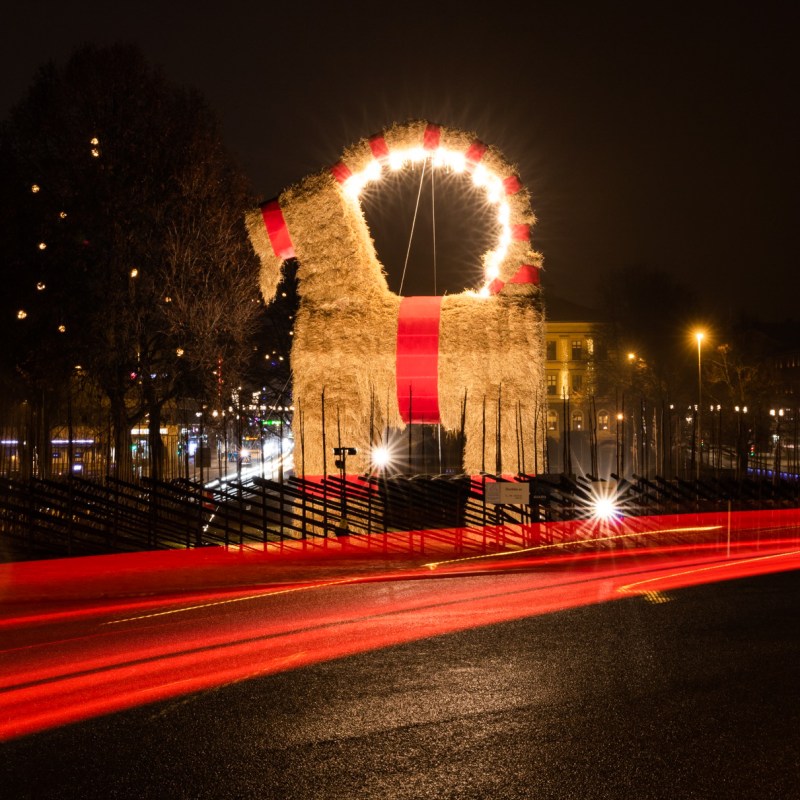
If you’re trying to understand another culture, look at how they celebrate their holidays — and pay special attention to the Christmas season. Customs vary greatly from one country to the next, but in most countries with significant Christian populations, Christmas is a big deal.
Videos by TravelAwaits
Most countries share a few common traditions: For example, most revelers know of Santa Claus, though the big guy’s name and appearance vary. However, countries also have Christmas traditions that are truly one of a kind.
Here are a few of our favorite examples — and how to celebrate like a local if you find yourself traveling to one of these destinations during the holidays.

1. Japan: KFC Christmas Dinners
When the fast-food chain KFC opened its first store in Japan in 1970, the restaurant’s manager, Takeshi Okawara, came up with a brilliant idea: Christmas “party barrels” with enough food to feed an entire family. The promotion was called Kurisumasu ni wa Kentakkii (Kentucky for Christmas), and it was wildly successful. Today, 3.6 million Japanese families buy KFC for Christmas every year, with some consumers weathering long lines to purchase the fried food.
Of course, travelers don’t need to embrace every tradition. If you find yourself in Japan around Christmastime and you’re not in the mood for fried chicken, stop by any bakery in any major city to pick up Kurisumasu keki, a light, airy Christmas cake topped with red strawberries.

2. Norway: Hiding Brooms
In Norway, witches and evil spirits are said to roam the streets during Christmas. To prevent witches from taking flight, Norwegians hide their household brooms before going to sleep at night. Hey, it’s logical, right?
Visitors can’t easily participate in this Christmas tradition for obvious reasons, but since Norwegians celebrate the holiday throughout the winter, tourists have plenty of alternatives. Try visiting Tregaarden’s Christmas House in Drobak to browse souvenirs at Santa’s workshop.

3. Budapest, Hungary: Christmas Markets
Granted, many countries have Christmas markets, but few can compare with the Christmas Fair by the Basilica or the Christmas Market on Vorosmarty Square. In Budapest, Christmas is a big deal, and each year, the streets transform; small wooden storefronts appear on the main streets, selling gifts, souvenirs, and holiday foods like chimney cake.
Tourists should be sure to check out the Hungarian folk dance shows and other special winter events. There’s no better time of year to dive into Hungarian culture, and Budapest certainly offers an abundance of fun activities for travelers of all ages.

4. San Fernando, Philippines: Giant Lantern Festival
From mid-December through early January, the aptly named Giant Lantern Festival takes over the streets of San Fernando in the Philippines. As the city’s official website explains, lanterns have a special significance in Filipino culture, since the lights symbolize hope.
During the celebration, you’ll see intricate handcrafted lanterns everywhere in a variety of shapes, sizes, and colors. Christmas songs fill the air, creating a stunning spectacle of light and sound that draws more than 100,000 visitors each year.

5. Mexico: Posadas
For the nine days leading up to Christmas Eve, Mexican children visit the houses of their families and friends in a reenactment of Mary and Joseph’s pilgrimage to Bethlehem. After reaching their destination, the children sing a song, then ask for a room at the posada (inn). The “innkeepers” let them inside, where they celebrate with food and games.
As Christmas is a somewhat private affair in Mexican households, tourists can’t really enjoy posada parties for themselves. Still, major urban areas like Mexico City have stunning Christmas celebrations to delight visitors; stop by the city square to see the decorations, and then head to Cantina La Rambla to try the restaurant’s famous tortas de bacalao, a salted cod dish commonly served on Christmas Eve.

6. Gavle, Sweden: Yule Goat
Gavle celebrates Christmas by constructing a massive straw goat. Townsfolk take bets on whether the goat will make it to Christmas — because, inevitably, someone sets it on fire. The tradition started in 1966, and over the past half-century, the goat has burned 35 times.
The Gavle city council has hired guards, put up security cameras, and launched other efforts to dissuade acts of vandalism, but the burning of the Yule Goat is an established part of the city’s culture.
By all means, visit Gavle during the Christmas season, but don’t try to burn the goat yourself. In 2005, an American tourist successfully completed the act — and then spent two weeks in jail for the crime.

7. Colombia: Day Of The Little Candles
On the Dia de las Velitas, or the Day of the Little Candles, Colombians adorn their homes and businesses with candles, paper lanterns, and electronic displays to signal the start of the Christmas season. People make a wish for every candle they light.
The exact timing of the Day of the Little Candles varies by region, but most Colombian cities celebrate on December 7. In the capital of Bogota, thousands of attendees make their way down the Christmas Route (Ruta de la Navidad), where stunning light displays cover the path.

8. Iceland: Yule Lads
The Jolasveinar are 13 mischievous troll-like beings who descend from the mountains, one at a time, starting on December 12. Each Yule Lad causes a different type of mischief, but they leave behind gifts for good children (and potatoes for naughty kids).
Walk through Reykjavik in December, and you’ll likely see the Yule Lads in the city’s Christmas decorations.

9. Greece: Christmas Boats
While Greeks love the holiday season, you might not see Christmas trees adorning their town squares. Instead, you’ll find karavakia (literally, “little ships”). These masted boats are typically decorated with fairy lights, and they’ve been a tradition for several hundred years.
So, why boats? Centuries ago, many Greeks worked as sailors, spending months at sea. They’d come home around Christmastime, and their families would decorate boats to welcome them back. Today, the tradition is found throughout the country, though the most captivating examples are found in major cities like Thessaloniki and Athens.
We’re just scratching the surface, of course; every country celebrates the holidays in its own way, which is part of the fun of the season. If you’re traveling this year, be sure to research your destination to understand its Yuletide customs — and, again, make sure not to burn any goats.

